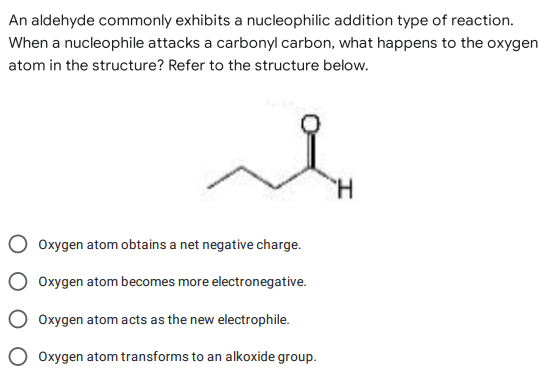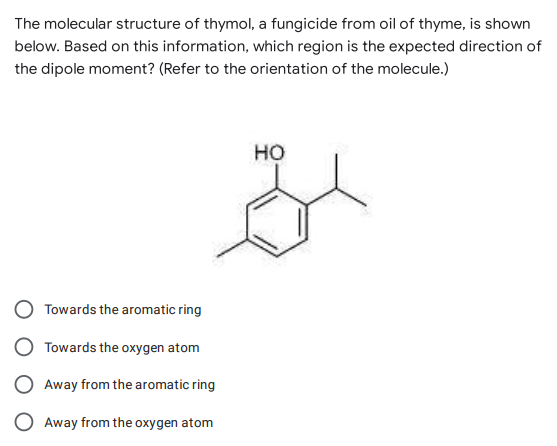An aldehyde commonly exhibits a nucleophilic addition type of reaction. When a nucleophile attacks a carbonyl carbon, what happens to the oxygen atom in the structure? Refer to the structure below.
An aldehyde commonly exhibits a nucleophilic addition type of reaction. When a nucleophile attacks a carbonyl carbon, what happens to the oxygen atom in the structure? Refer to the structure below.
Organic Chemistry: A Guided Inquiry
2nd Edition
ISBN:9780618974122
Author:Andrei Straumanis
Publisher:Andrei Straumanis
ChapterNW4: Nomenclature Worksheet 4: Carbonyl Compounds
Section: Chapter Questions
Problem 11CTQ
Related questions
Question
Answer the following:

Transcribed Image Text:An aldehyde commonly exhibits a nucleophilic addition type of reaction.
When a nucleophile attacks a carbonyl carbon, what happens to the oxygen
atom in the structure? Refer to the structure below.
H
Oxygen atom obtains a net negative charge.
Oxygen atom becomes more electronegative.
Oxygen atom acts as the new electrophile.
Oxygen atom transforms to an alkoxide group.

Transcribed Image Text:The molecular structure of thymol, a fungicide from oil of thyme, is shown
below. Based on this information, which region is the expected direction of
the dipole moment? (Refer to the orientation of the molecule.)
HO
Towards the aromatic ring
Towards the oxygen atom
Away from the aromatic ring
Away from the oxygen atom
Expert Solution
This question has been solved!
Explore an expertly crafted, step-by-step solution for a thorough understanding of key concepts.
Step by step
Solved in 2 steps with 2 images

Knowledge Booster
Learn more about
Need a deep-dive on the concept behind this application? Look no further. Learn more about this topic, chemistry and related others by exploring similar questions and additional content below.Recommended textbooks for you

Organic Chemistry: A Guided Inquiry
Chemistry
ISBN:
9780618974122
Author:
Andrei Straumanis
Publisher:
Cengage Learning

Organic Chemistry
Chemistry
ISBN:
9781305580350
Author:
William H. Brown, Brent L. Iverson, Eric Anslyn, Christopher S. Foote
Publisher:
Cengage Learning

General, Organic, and Biological Chemistry
Chemistry
ISBN:
9781285853918
Author:
H. Stephen Stoker
Publisher:
Cengage Learning

Organic Chemistry: A Guided Inquiry
Chemistry
ISBN:
9780618974122
Author:
Andrei Straumanis
Publisher:
Cengage Learning

Organic Chemistry
Chemistry
ISBN:
9781305580350
Author:
William H. Brown, Brent L. Iverson, Eric Anslyn, Christopher S. Foote
Publisher:
Cengage Learning

General, Organic, and Biological Chemistry
Chemistry
ISBN:
9781285853918
Author:
H. Stephen Stoker
Publisher:
Cengage Learning

Organic And Biological Chemistry
Chemistry
ISBN:
9781305081079
Author:
STOKER, H. Stephen (howard Stephen)
Publisher:
Cengage Learning,